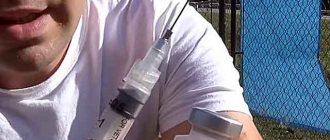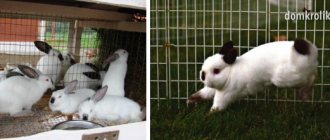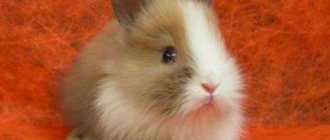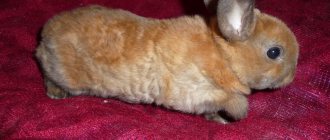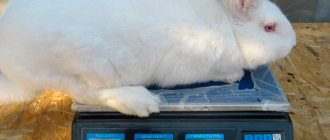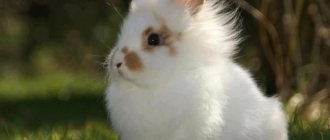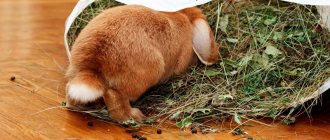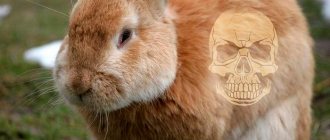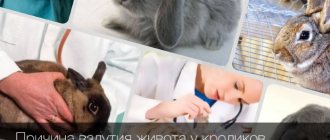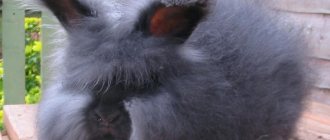How are rabbits bred?
If a farmer decides to breed rabbits, engage in mating and littering, he should know the methods of breeding these furry animals. There are only three ways:
- Breeding at home in a natural environment. For effective fertilization, it is necessary to place the male and female in the same cage for two days and observe them so that the natural process occurs. Not everything can always work out the first time, even if you wait a longer period of time. Therefore, some farmers immediately plant several females and one male.
- Breeding rabbits with human participation. This method is practically no different from that described above, only in this case you should hold the female so that the male can cover her.
- Breeding on large farms. This method is used when many rabbits are bred. Therefore, for maximum confidence in the result, insemination of females is carried out using the artificial method. Of course, this method cannot be called simple, since in order to turn your plans into reality, you need to know several nuances. First of all, it is necessary to collect the sperm of rabbits, and only the venerable ones, and then place the sperm inside the rabbit using a syringe.
Mating schedule and male diet
It is difficult to record the moment of coverage during mating games. At first, the partners run after each other, then the female stops and presses herself to the floor.
If the chase continues for a long time, the female is held back and the rabbit is allowed to mate.
It is difficult to record the moment of coverage during mating games
To guarantee, after resting for 5-10 minutes, re-coating is carried out. After mating, the female rabbit is placed in a separate cage, and the date of mating is recorded in a journal.
During the mating period, one male is able to fertilize up to 8 females. The intensity of mating of a male is no more than 2 rabbits per day: in the morning and in the evening.
It is better to mate young males no more than 5-6 times a week.
2 weeks before mating, it is necessary to adjust the rabbit’s nutrition. Food should be high in calories and rich in vitamins.
The diet includes boiled potatoes, concentrated feed (CC, PC), leguminous and cereal crops (oats, wheat bran, corn), oilseeds, mixed feed, cakes, feed yeast, mineral supplements and vitamins.
Determination of gender
Before you start breeding rabbits, you should determine their gender. This is not as simple as it might seem at first glance. Moreover, such an activity will seem difficult for a person who is encountering this for the first time.
To determine the sex, you need to place the rabbit on its back, lower its tail, and press with your fingers on both sides near the rabbit's genitals. In a female individual, the genitals look like a loop or hood with a slit (genital slit). In males, the genital organ is formed in the form of a tube with a round hole in the middle.
Lay the rabbit on its back
Press on both sides to bring out the genitals
The female genitalia looks like a loop
Female rabbit genital slit
The male rabbit's external genitalia has the shape of a tube.
Rabbit reproductive organ
Sexual and physiological maturity of rabbits
Like all living creatures on earth, rabbits reach the age of formation of secondary sexual characteristics - this is the age of puberty, followed by the time of real maturation. We have already talked about the stages of maturity of rabbits, see reproduction.
Photo. Rabbits start mating early
Choosing the right rabbit
Choosing a female rabbit for mating is not so difficult. First, assess the age of the animal: the female should not be younger than 6 months, since at a younger age she will not be able to bear offspring normally. Of course, the best option would be young individuals who have already given birth to rabbits and then conscientiously fed them. In this case, already 45 days after the previous litter, the female can be bred again.
It happens that a mother rabbit eats her babies. If this happened, there is no need for this female to happen again.
An equally important criterion for choosing a young rabbit to mate with is her weight. The female should be moderately well-fed, but not suffer from obesity. If the animal is thin, you should start fattening it. The female rabbit must be in the hunting stage, because without this the mating will not work. If a specific day of the month has been selected for mating, the female should be separated from her relatives for a while.
Where to keep and what conditions need to be created for a pregnant rabbit
A pregnant rabbit should be placed in a separate spacious cage, the dimensions of which can accommodate 6 adults, because after giving birth, the female will stay there with her offspring until the rabbits are weaned from her. This must be done in the first days after conception, since moving a pregnant female after she has begun to build a nest will be stressful for her. The cage should be in a quiet place where the animal will not be disturbed.
A few days before the expected birth, it is necessary to disinfect the cage and dishes, and also place a box made of cardboard or wood with an entrance, which will act as a nest. Straw should be laid on its bottom. In winter, it is necessary to take measures to insulate the cage with the offspring - cover the sides and top with foam, pour a thicker layer of straw on the bottom. In summer, the cage should be in the shade. Good ventilation should be present at any time of the year. The ambient temperature should not be higher than +30°C or lower than -6°C.
Read more about pregnancy in rabbits.
It’s good if the temperature is in the range of +18…+22°C. Lighting should be at least 12 hours a day. There should be no drafts or dampness. Pregnant and lactating rabbits should always be provided with clean drinking water. The diet must include vegetables, grains and fresh grass (or hay). Meat and bone meal, fish oil and vitamins should also be given. Animals should not be overfed or underfed - nutrition should be according to the norms recommended for pregnant animals.
How do you know when it's time to mate rabbits?
To reproduce offspring, you must wait until the rabbits reach full puberty. The age at maturity is slightly different for each breed. Next, you need to wait a couple more months for your body to get stronger. It turns out that on average, the first mating takes place at 5-6 months. This is the most optimal age.
If the rabbit begins to actively mark the territory, this indicates that the male is ready for mating. Requirements for males:
- activity;
- healthy appearance and sufficient weight.
If a rabbit sheds, it is better to postpone mating for this period, since in a state of molting the animal’s immunity is weakened, which can negatively affect the quality of the litter.
As for the female, she must have a desire to mate. This is easy to understand: the female’s behavior becomes restless, she often moves around the cage, and can pluck her down to improve the future nest. In addition, the female's loop swells and acquires a bright pink color. And if you stroke the rabbit’s back, she will lie down and begin to stretch out. Sexual desire in females occurs regularly (every 7-9 days).
You can mate rabbits without the female hunting, but the effectiveness of such mating will be low, since the rabbit’s body needs about 5 days to mature the eggs. Therefore, it is still recommended to regularly check the female’s heat before mating. And during the mating process itself, you need to hold the female rabbit so that her back is raised and her tail does not interfere with the penetration of the male’s genital organ into her.
The female is considered covered when the male, after a couple of minutes of rapid movements, abruptly stops in a certain position or jumps off the female, making snoring sounds. Mating can be repeated after 5-7 days. The convenience is that you don’t have to wait for the right day to mate.
While in humans pregnancy can only occur on certain days, in rabbits ovulation occurs spontaneously immediately after intercourse. Nature intends for rabbits to reproduce regularly. By the way, female rabbits do not have estrus (menstruation).
If the female refuses to accept the male upon repeated mating, then most likely she is already pregnant. You need to carefully feel her lower abdomen. In a pregnant female, on days 13-15 after successful mating, two parallel threads of soft balls the size of a cherry will be palpable. The rabbit is placed separately and is no longer probed so as not to cause a miscarriage.
Timing for fertilization
Female rabbits can become pregnant as early as 3 months. Sexual maturity of males occurs a little later. To get a good offspring, rabbit breeders advise starting mating at the age of six months. But it is also worth considering the weight of the animal. If the female rabbit has gained 2/3 of the weight of an adult (about 3-4 kg), then she is already suitable for insemination.
After mating, fertilization and gestation (pregnancy) occur. But you can definitely be sure of conception only two weeks after mating. Gestation lasts approximately 30 days. The exact number of days depends on the breed and the number of cubs in the litter.
First mating
Before the first mating, two weeks before the first mating, the rabbits are examined for fatness, their health status is determined, and their diet is adjusted.
The first mating is carried out taking into account age, live weight and molting. Young rabbits are allowed to meet a male for the first time at about 5-6 months. Large purebred rabbits are allowed to mate another 16-35 days later. But overexposure of animals is also not worth it - it becomes unprofitable in financial terms, and animals during overexposure become fat, covered with fat and do not inseminate well.
Males mate for the first time when they reach 6-8 months.
It is usually recommended that young inexperienced females be allowed to be with adult males, and female rabbits that have already given birth be allowed with young inexperienced rabbits.
When can you give birth to a female rabbit after giving birth?
On the second day after giving birth, the female is physically ready to become covered. But there is no need to rush, because part of its reserves is spent on feeding the newborn litter. Without giving the animal's body a chance to recover, the immune system and maternal instincts can be weakened in the future.
For the mating of females after litter in rabbit breeding, there are a number of breeding methods - industrial technology, the method of compacted litters and a standard breeding scheme.
The method of semi-compacted litters is also sometimes used. In this case, mating is carried out two weeks after birth.
How long can you keep a female rabbit for offspring?
The average lifespan of rabbits is 8–10 years. But this does not mean that the rabbit is able to reproduce all the time. After approximately the seventh birth, the number of individuals in the litter decreases, the survival rate decreases, and milk production decreases. Females begin to gain weight and their sexual activity decreases. When breeding, it is necessary to take into account all the nuances individually for each representative of the long-eared family. The main task of the breeder is to promptly cull the female unsuitable for breeding.
Farmers usually use female rabbits for about two years.
At what age can rabbits be bred?
To determine the age for mating as correctly as possible, one should take into account the fact that rabbits do not live long, about 9-10 years, and already from the 5th year of life the percentage of successful matings drops, therefore it is recommended not to mate. In addition, in old age there is a sharp decrease in the volume of milk in female rabbits after the birth of offspring, so the female cannot feed them on her own.
In rabbits, the process of aging and the extinction of maternal instincts is an individual feature. It often happens that, by all academic parameters, a male or female is subject to culling, but at the same time they still produce numerous and healthy offspring. But as statistics show, regardless of the age at which the first mating occurred, the animal can give birth to strong young rabbits during the first 2-3 years of its life.
The process of gestation and childbirth
After mating, the female can carry the pregnancy for a different period of time. Most often, the period depends on how many rabbits she is pregnant with. Interestingly, the more fertilized eggs were formed and embryos were formed from them, the shorter the gestation period. Most often, the period ranges from 29 to 34 days.
By the way, the same dependence of the duration of pregnancy on the number of embryos also appears in other domestic and farm animals.
The breeding occurs quite quickly - a maximum of 1 hour if it goes through the stage. But most often it takes about 20-30 minutes.
Although, there is another option - the female rabbit brings several rabbits during the first call, then an interval of about 1 day is maintained and a second litter occurs, during which the rest of the babies appear.
The mother always licks the newborns, feeds them with milk and wraps them in collected fluff. If we talk about average fertility, it is about 8 rabbits, although there are cases when females brought up to 19 babies.
The presence of offspring is not a reason for a female to cancel sexual hunting. Quite often, immediately after the babies are born, the female rabbit develops a need for further copulation. This condition is in no way related to lactation and pregnancy can occur while the mother is breastfeeding her babies.
Rabbits mating
Despite the fact that there is an expression “to mate like rabbits,” these animals are quite selective in choosing a sexual partner. That is why, in a farm with a large number of rabbits, a person has to take part in the natural process.
You can take a male and several females. But more often than not, a couple is planted, while monitoring the entire process and, if necessary, holding the female so that she does not spin. Mating is a fairly quick process, lasting no more than 2 minutes. The male can be presented with several females per day for mating (mating) at intervals of approximately 4 hours (this time is necessary to restore sperm quality).
It is not recommended to cover more than 4 females per day. After each mating, the female is returned back to the cage.
During mating, rabbits should get rid of all the contents in the cage, leaving only a drinking bowl with water. You should not leave animals alone, as there is a possibility of a fight. Often experienced females do not accept young males. Experts believe that their smell is not as sharp and desirable for females as the smell of mature males.
How to check the result
The female's pregnancy can be determined 10-12 days after the “date”. The animal is positioned with its head towards itself, held by the withers with one hand, and the lower part of the abdomen is carefully probed with the other. During this period, the fertilized uterus can be felt as an oval-shaped compaction in the pelvic area.
Behavior changes: the female in the cage behaves calmer, her appetite improves, while she may be wary of the owner and not give in to the hands. During the control replanting, the pregnant female will not allow her partner to approach her.
Did you know? In Australia, it is not recommended to keep rabbits as pets, and in the state of Queensland it is even prohibited by law and faces a fine of up to 30,000 Australian dollars.
How long pregnancy lasts in rabbits depends on the number of embryos. It usually lasts about 30 days; The larger the litter, the shorter the pregnancy. During this period, the rabbit needs peace, comfort, the absence of high humidity and drafts, good nutrition, mainly succulent food, and a sufficient amount of water.
For successful mating of rabbits, it is necessary to take care of the animals, create comfortable conditions for them, and observe their behavior in order to choose the optimal moment. If you follow these principles, you will definitely achieve your goal.
When to breed rabbits after breeding offspring?
You should know how much time should pass after giving birth. Of course, it is useful to take a certain pause, since the female’s body needs time to recover after childbirth. On average, a female rabbit should not be bred until about 45 days after giving birth. At this time, the female and the babies should be placed in a separate cage.
It is also important to isolate pregnant females from males. This is necessary in order to avoid mating of a male with a female rabbit in position, since this can harm the offspring, for example, the rabbits may be born dead. In addition, a rabbit's uterus has such a structure that she can become pregnant again while already carrying baby rabbits in the womb. The second offspring in this case will be weak.
Pregnancy (pregnancy) of a female lasts about a month. A few days after giving birth, the female may begin to behave restlessly, refusing to give up her babies. Then a “single” mating is carried out. To do this, take a male and alternately (without pauses) introduce him to several female rabbits. Immediately after the last mating, a rabbit who recently gave birth is brought to the table. The sperm of such a male will be inactive, therefore she will not become pregnant, and the female rabbit will go into hunting and will return to the rabbits.
But keep in mind, in this case, the first female that is placed with the male will turn out to be pregnant!
How to determine if a rabbit is pregnant
Pregnancy of rabbits is determined using several methods:
- Measuring the female's mass. A pregnant animal gains 0.029 grams in the first week of pregnancy, 0.057 grams in the second week, and then the weight does not change.
- Ultrasound of an animal. It is done in a veterinary hospital and shows the most reliable results. It is carried out a week after the estimated fertilization.
- Observing the behavior of the female. She becomes quiet, cautious, and does not let the male near her. Before giving birth, female rabbits usually make a nest and line it with fur and hay.
- Palpation of the rabbit. The female's abdomen is palpated. About two weeks after probable conception, the fetus can be detected in this way. Previously, this procedure was not recommended so as not to harm the babies in the womb. The found embryos will feel like small cherries to the touch.
For novice breeders, it is not recommended to palpate an animal without relevant experience.
Physiological exceptions to pregnancy of a female rabbit outside the cycle
Among animals, only female rabbits are fertilized outside the ovulation cycle. This will be possible if: - unfertilized eggs are preserved in the genital tract between cycles; - they use a very good breeding rabbit, which can cause the female to release an egg reflexively; - hormonal estrus-stimulating drugs are administered.
Such fertilization without hunting in female rabbits is quite possible, but does not provide a complete guarantee of insemination.
Why don't female rabbits cover themselves?
There are a number of reasons why a rabbit does not become pregnant.
Physiological problems during mating: - lack of sexual estrus; - already pregnant; - superfetation (repeated pregnancy).
Psychological problems during mating: - the female rabbit is very frightened and afraid of everything that surrounds her (including the male); - stress received the day before; - the female’s desire to flirt longer; - very young partners and they have no experience in such a matter.
Physical problems: - non-compliance with the temperature regime in the room; - improper diet and water intake.
What is inbreeding?
Inbreeding is the inbreeding of two rabbits. In most cases, it is undesirable to do this, since as a result the offspring may be born unhealthy and weak. But this applies specifically to closely related inbreeding. There is also distant inbreeding, which is even advisable to carry out in order to obtain a stronger breed of rabbits.
Inbreeding is not always well thought out; it often becomes the cause of a person’s shortcomings if the hereditary recording of livestock and mating schedules were carried out incorrectly. To correct the error, it is important to introduce new individuals into the rabbit family, preferably males, since with their help it will be possible to straighten the family line of the animals and obtain healthy offspring.
Animal culling
2 weeks before mating, rabbits are carefully examined.
Rejection criteria:
- Age over 3 years.
- Loss of maternal instinct and killing of offspring. Frequent mating leads to exhaustion of the body, the rabbits are born weak and non-viable.
- Repeated miscarriages in the female rabbit and stillbirths.
- The presence of diseases , rashes, abrasions, tumors, purulent discharge and unhealthy condition of the reproductive organs. Animals are inactive, have a weak appetite, physical injuries to their paws and other abnormalities.
- Underweight or overweight. Excessively obese animals inactively engage in mating or completely refuse to mate. Skinny rabbits have weak, non-viable offspring.
Be sure to read:
How to determine the sex of a rabbit: external differences, sexual characteristics, behavior
Culled but healthy rabbits are fattened and sent to slaughter. Individuals with external signs of the disease are urgently destroyed.
Important! Only a veterinarian can diagnose diseases in animals, including infectious ones.
Mating rabbits in winter
Of course, you can mate rabbits throughout the year. But the mating of animals in winter requires special attention. Many farmers are concerned that low temperatures may pose a problem for successful mating. To do this, morning hours are chosen for mating so that the sun sufficiently warms the room where the rabbits are kept.
The mating process of rabbits in winter is carried out in the same way as in other seasons. In addition, there are some breeds of rabbits that can continue mating even if the heat source is completely absent. Of course, such conditions should not be allowed: home farms must have a temperature of at least 12 degrees.
The only thing you should be wary of is drafts, since they are terrible enemies that make rabbits get sick. Drafts can cause poor quality mating. In winter, this process requires increased comfort in keeping animals.
After the mother rabbit brings the rabbits into the cold period, you need to warm them up as much as possible. If there is no battery or heater in the rabbitry, it is recommended to take the offspring into the house so that the babies get stronger and gain strength.
Methods for assessing puberty based on a rabbit's body type
The second thing people pay attention to when grading young rabbits is their physique. For example, based on the body condition, the presence of possible metabolic disorders in the animal’s body is assessed. Based on these signs, you can quite accurately determine the readiness of male and female rabbits for the first mating.
Photo. Visual assessment of the physique of a Californian rabbit
Preliminary grading with a high degree of confidence reveals defects that rabbits acquired at the stages of embryonic development and after birth. Defects in physique usually prevent a rabbit from being ready to begin mating, sometimes indicating the reasons for the impossibility of determining the time when rabbits can be mated. The physique is checked by external examination; if necessary, measurements are taken or the width and girth of the chest are determined by eye. They give an assessment of the size of the head (shape, size, ratio to the body). Pay attention to the lines of the body, including the back and croup. Based on the correct placement of the limbs, a conclusion is made about the absence or presence of rachitic signs.
Photo. Landmarks on a rabbit's body. 1- head, 2- neck, 3- ears, 4- scruff, 5- shoulder, 6- side, 7- back, 8- croup, 9- tail, 10- ankle joint, 11- hip, 12- hind limb, 13-stomach, 14-forelimb, 15-chest, 16-claws, 17-dewlap
The sequence of inspection and measurements is as follows:
- The head is proportional to the body, without deformations, massive in males, delicate in females.
- The ears of the main agricultural breeds are erect.
- The neck is proportional, holds correctly in relation to the body, there is no curvature.
- The chest is well developed, respiratory movements are rhythmic, deformations and thickenings on the ribs are not palpable.
- The back is without curvature in the vertical and horizontal directions.
- The croup is round, sensitivity is normal.
- The limbs are positioned correctly in relation to the body.
- The muscle tissue is dense, textured, the fat layer is not noticeable.
- The hairline is smooth, shiny, and meets breed standards.
Assessment of the physique of decorative (dwarf) rabbits to determine readiness for mating is approximately the same as for productive rabbits.
Why are matings unsuccessful?
Sometimes it happens that despite the efforts made, the rabbit does not become pregnant. First of all, do not be upset, because in a few days you can re-mate the rabbits. But in order to get better results, you should change the male, since he may be too young to mate.
In this case, an unsuccessful mating is often due to the fact that not all the male’s sperm gets into the internal organs of the female. But this problem can also be overcome: it is necessary to hold the female rabbit correctly so that the rabbit can complete the insemination process without a hitch.
Knowing how and at what age to breed rabbits, you will be able to learn how to mate them correctly so that the female gives good, healthy offspring. Only with the right approach to the process and creating comfortable conditions for the female and male, will it be possible to breed both decorative and farm rabbits.
0
0
Copy link
Where to drop off kids
Young rabbits should only be placed in clean, disinfected rabbit hutches. In a new home, rabbits should feel free. The children's cages are made spacious, dry, and warm, so that there are no drafts. It is better to make the bottom of the house wooden or plastic. Sawdust, soft straw, pieces of fabric or cardboard are suitable for bedding. The bedding material must be dry, free of putrefactive inclusions and parasites.
It is recommended to house breeding individuals separately - immediately after sex determination. Females that are planned for mating can be housed two or three in cages. But it is better to place breeding males in individual housing, since they begin to fight at puberty.
For the rest of the offspring that will be slaughtered, one cage is suitable - for 3-7 long-eared animals. 10-15 animals can be separated into enclosure structures. It is worth considering that for one rabbit, at least 0.2 m2 of rabbitry area is required.
It is not advisable to combine animals from different litters in one cage. If absolutely necessary, it is better to place everyone together in a new house. Then they watch the animals for some time. To prevent injury, fighting rabbits are advised to be separated from the general group and transferred to separate cages.
It is forbidden to place young animals with older relatives. Adult rabbits will fight with the younger generation, provoke unequal fights, and drive them away from feeders. And this will affect development, growth, and may cause the death of growing offspring.
Video At what age is it better to separate baby rabbits from a female rabbit?
Coating process
Now let's find out how to breed rabbits for the first and subsequent times. In small farms where it is not possible to carry out artificial insemination, two mating methods are practiced:
- Adding a female rabbit to a male for a long period of time - 5-7 days . In this situation, the animals themselves will decide on the optimal mating option. At first, it is advisable to observe the animals. Cases of fights if you don’t like your partner are not uncommon. If the partners are aggressive and the matter ends in a fight, then the animals should be seated to avoid serious injury;
- The second option is a short-term replanting of the female for 2-3 hours . The disadvantage of this method is the need for constant monitoring and, possibly, intervention by the rabbit breeder. Determining the moment of coverage visually is not difficult. It lasts for half a minute. After covering, the rabbit falls over on its side and emits a characteristic squeak - a signal to the rabbit breeder that the partners can be seated. If the partners flirt too much and do not have intercourse, then experienced rabbit keepers simply hold the female rabbit with their hands, allowing the male to do his job faster.
Proper preparation of a rabbit for breeding
The key stage of preparation for mating is determining the rabbit’s readiness for motherhood, otherwise called the hunting period. Its duration is 3-5 days depending on the season.
Between periods of heat, mating is unlikely. The breaks between the next female hunt also range from 5 to 10 days. In winter, they can last longer, as the sexual activity of animals decreases.
You may be interested in the following related articles:
- How to feed small rabbits correctly?
- How long does pregnancy last in rabbits and how to give birth correctly?
- Features of breeding rabbits in a pit.
Determining the hunting period is quite simple. This is evidenced by:
- Increased activity of the rabbit;
- Plucking belly fluff;
- Preparing materials for the nest.
To be sure, the condition of the rabbit’s genital organ, called the loop, is checked. Its redness and swelling clearly indicate that the female is in heat.
There are no such restrictions for males.
Immediately before mating, it is important to properly prepare the cage.
Rabbits are mated only in the male's cage. Many years of experience show that adding a male to a female, as a rule, does not produce a positive effect. A similar rule applies to “neutral” territory.
Remove everything unnecessary from the rabbit's cage, including the drinking bowl and feeder. The animals will not have time to eat. The cage must be washed and disinfected. Only after this can you place the rabbit with your partner.
Video
This video will tell you about the rules for mating rabbits.
The mating of rabbits must be carried out prudently, having clearly determined in advance the condition of the animals - age, body weight and breed. Animals should be prepared for this important event in their lives. For everything to go smoothly, you need to carefully study the rules for mating rabbits and avoid making mistakes in this process. Then stories about the fertility of rabbits will become for you not just someone’s unfounded statements, but real life practice. Find out how long dwarf breeds live from this article.
Is it possible to cross relatives so that they reproduce?
Mating of relatives among rabbit breeders is called inbreeding. There is a lot of debate about it: on the one hand, any schoolchild knows how dangerous family ties are, on the other hand, it is precisely such mating that leads to the creation of new breeds.
Rabbit breeders sometimes engage in forced inbreeding. For them you need to give some tips:
- Try to select pairs with the most distant degree of relationship, and avoid the formation of the following pairs: father and daughter, mother and son, brother and sister from the same litter.
- Do not mate unhealthy animals or those with any deviations in physical development.
- If it was not possible to follow these tips, it is best to send the resulting offspring to slaughter. Otherwise, after several generations the animals will become shredded and their fertility will decline.
- To obtain animals with good breed characteristics, it is best to take animals with a pedigree that is known to you up to the fifth generation.
Maybe,
Refusal of the female rabbit to mate
If the female rabbit does not allow the rabbit to approach, then rabbit breeders choose one of the following options:
- The animals are placed next to each other after some time, for example, after 2-3 hours. If the situation repeats, then the procedure is repeated every other day;
- If the first method does not work, then you can change the male. Often this option is the most successful.
It is necessary to distinguish between refusal to mate and too prolonged mating fuss. In the second case, the rabbit simply needs help to speed up the procedure. Refusal is evidenced by the female’s aggression and reluctance to allow the male to approach her at all.
